TYAUX-J2 Module Datasheet
Last Updated on : 2025-11-13 09:55:07download
TYAUX-J2 is a Wi-Fi and Bluetooth low energy (LE) combo module developed by Tuya Smart. This module has a highly integrated wireless radio frequency (RF) chip W701-VA2-CG with built-in Wi-Fi stacks and various library functions.
Overview
TYAUX-J2 combines a low-power KM4 microcontroller unit (MCU), WLAN MAC, and 1T1R (1 transmitter/1 receiver) design. This module provides output frequency up to 100 MHz, 256 KB embedded SRAM, 2 MB flash memory, and configurable GPIOs that can function as digital peripherals for diverse applications.
TYAUX-J2 is a real-time operating system (RTOS), integrated with all Wi-Fi MAC and TCP/IP libraries. All these resources can help you develop your own embedded Wi-Fi products.
Features
- Built-in low-power KM4 MCU that also acts as an application processor.
- Clock rate of 100 MHz.
- Operating voltage range: 4.5V to 18V.
- Peripherals: 1 universal asynchronous receiver/transmitter (UART) pin.
- Wi-Fi and Bluetooth connectivity
- IEEE 802.11b/g/n20.
- Channels 1–14@2.4 GHz (CH1–11 for US/CA and CH1–13 for EU/CN).
- Support security protocols, including WEP, WPA, WPA2, and WPA2 PSK (AES).
- Support Bluetooth LE 4.2.
- Support Wi-Fi Easy Connect (EZ mode) pairing mode on Android and iOS devices.
- Onboard PCB antenna.
- It has passed CE and FCC certifications.
- Operating temperature range: -20°C to +85°C.
Applications
- Smart building
- Smart home
- Smart socket
- Smart lighting
- Smart bus
- Industrial wireless control
- Baby monitor
- IP camera
Module interfaces
Dimensions and footprint
The TYAUX-J2 module dimensions are 50.85±0.35 mm (W) × 19.5±0.35 mm (L) × 4.6±0.15 mm (H). The figure below shows the dimensions of the TYAUX-J2 module.
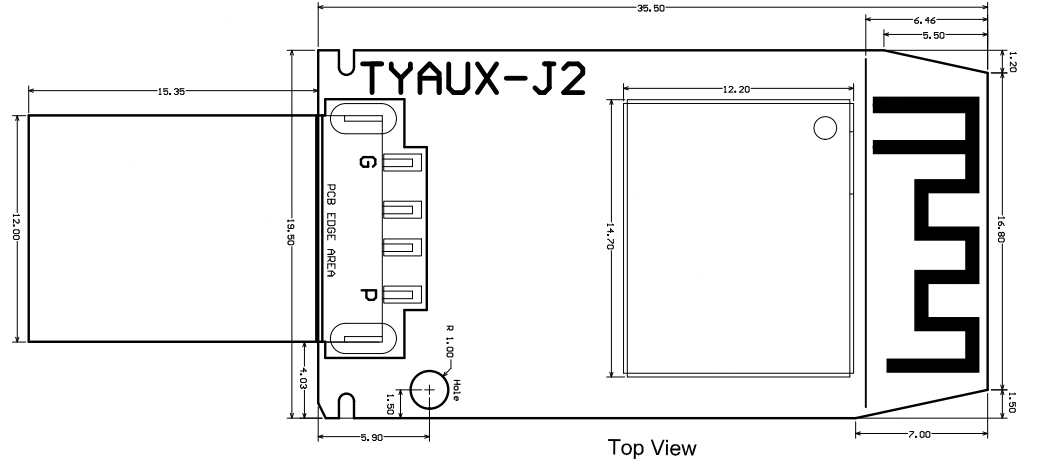

Electrical parameters
Absolute electrical parameters
| Parameter | Description | Min value | Max value | Unit |
|---|---|---|---|---|
| Ts | Storage temperature | -40 | 105 | °C |
| VDD | Supply voltage | -0.3 | 18 | V |
| Electrostatic discharge voltage (human body model) | TAMB -25°C | - | 2 | kV |
| Electrostatic discharge voltage (machine model) | TAMB -25°C | - | 0.5 | kV |
Operating conditions
| Parameter | Description | Min value | Typical value | Max value | Unit |
|---|---|---|---|---|---|
| Ta | Operating temperature | -20 | - | 85 | °C |
| VDD | Operating voltage | 4.5 | 12 | 18 | V |
| VIL | I/O low-level input | - | - | 0.8 | V |
| VIH | I/O high-level input | 2.0 | - | - | V |
| VOL | I/O low-level output | - | - | 0.4 | V |
| VOH | I/O high-level output | 2.4 | - | - | V |
| Imax | I/O drive current | - | - | 16 | mA |
| Cpad | Input pin capacitor | - | 2 | - | pF |
Radio frequency (RF) power
-
Power consumption during continuous transmission (TX)
Symbol Mode Power Average value Peak (Typical) value Unit IRF 802.11b, 1 Mbit/s 17 dBm 78 190 mA IRF 802.11b, 11 Mbit/s 17 dBm 82 193 mA IRF 802.11g, 6 Mbit/s 17 dBm 75 188 mA IRF 802.11g, 54 Mbit/s 15 dBm 62 179 mA IRF 802.11n, BW20 MCS0 17 dBm 68 192 mA IRF 802.11n, BW20 MCS7 14 dBm 55 198 mA -
Power consumption during continuous reception (RX)
Symbol Mode Average value Peak (Typical) value Unit IRF 802.11b, 11 Mbit/s 22 124 mA IRF 802.11g, 54 Mbit/s 23 128 mA IRF 802.11n, HT20 MCS7 23 125 mA
Power consumption in working mode
| Working mode | Status (Ta = 25°C) | Average value | Peak (Typical) value | Unit |
|---|---|---|---|---|
| Quick pairing (Bluetooth) | The module is pairing over Bluetooth. The network status indicator blinks quickly. | 28 | 198 | mA |
| Quick pairing (AP) | The module is in AP mode. The Wi-Fi network status indicator blinks slowly. | 31 | 196 | mA |
| Wi-Fi Easy Connect (EZ) | The module is pairing in EZ mode. The network status indicator blinks quickly. | 29 | 194 | mA |
| Connected and idle mode | The module is connected to the cloud. The network status indicator is steady on. | 26 | 196 | mA |
| Connected and operating mode | The module is connected to the cloud. The network status indicator is steady on. | 28 | 199 | mA |
| Weakly connected | The connection between the module and the access point is intermittent. The network status indicator is steady on. | 31 | 198 | mA |
| Disconnected | The module is disconnected from the cloud. The network status indicator is steady off. | 32 | 201 | mA |
| Module disabled | The module’s clock enable (EN) pin is pulled down. | 0.5 | 1.2 | mA |
RF parameters
Basic RF features
| Parameter | Description |
|---|---|
| Frequency range | 2.400 to 2.4835 GHz |
| Wi-Fi standard | IEEE 802.11b/g/n (channels 1–14) |
| Bluetooth standard | Bluetooth LE 4.2 |
| Data transmission rate |
|
| Antenna type | PCB antenna with a peak gain of 3.16 dBi |
Transmitter (TX) performance
-
Continuous transmission performance:
Parameter Min value Typical value Max value Unit RF average output power, 802.11b CCK mode, 1 Mbit/s - 17 - dBm RF average output power, 802.11g OFDM mode, 54 Mbit/s - 14 - dBm RF average output power, 802.11n OFDM mode, MCS7 - 13 - dBm RF average output power, Bluetooth LE 4.2, 1 Mbit/s - 6.5 - dBm Frequency error -20 - 20 ppm EVM@802.11b CCK 11 Mbit/s mode, 17.5 dBm - - -10 dB EVM@802.11g OFDM 54 Mbit/s mode, 14.5 dBm - - -29 dB EVM@802.11n OFDM MCS7 mode, 13.5 dBm - - -30 dB
-
Receiver (RX) performance:
Parameter Min value Typical value Max value Unit PER < 8%, RX sensitivity, 802.11b CCK mode, 1 Mbit/s - -96 - dBm PER < 10%, RX sensitivity, 802.11g OFDM mode, 54 Mbit/s - -75 - dBm PER < 10%, RX sensitivity, 802.11n OFDM mode, MCS7 - -72 - dBm PER < 10%, RX sensitivity, Bluetooth LE 4.2, 1 Mbit/s - -93 - dBm
Antenna information
Antenna type
This module has an onboard PCB antenna with a peak gain of 3.16 dBi.
Antenna interference reduction
When a PCB antenna is used on a Wi-Fi module, we recommend that the module antenna is at least 15 mm away from other metal components. This can optimize the Wi-Fi performance.
Power-on and power-off sequence
Power-on sequence
The W701 chip has requirements for the power-on sequence. It is recommended that the time for the voltage to rise from 0V to 3.3V should be within 20ms.
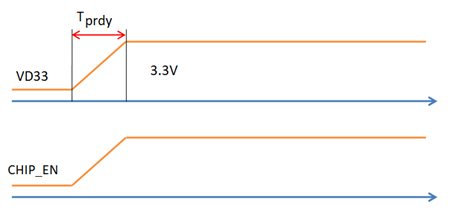
Power-off sequence

| Symbol | Parameter | Min value | Typical value | Max value | Unit |
|---|---|---|---|---|---|
| TPRDY | 3.3V ready time | 0.6 | - | 20 | ms |
| CHIP_EN | CHIP_EN ready time |
0.6 | - | 20 | ms |
| VBOR | Brown-out reset (BOR) occurs after 3.3V is lower than this voltage | 2 | - | - | V |
| TRST | The required time that 3.3V is lower than VBOR | 1 | - | - | ms |
Packing and production instructions
Mechanical dimensions
The TYAUX-J2 module’s PCB dimensions are 19.5±0.35 mm (W)×35.5±0.35 mm (L) ×1.0±0.15 mm (H). The figure below shows the mechanical dimensions of TYAUX-J2.

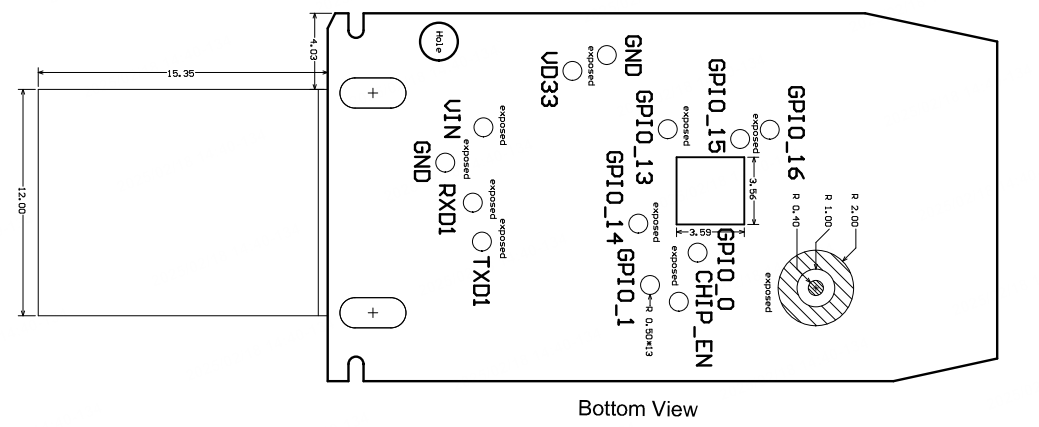

The default tolerance of the dimensions is ±0.35 mm. If you have special requirements for key dimensions, specify them in the datasheet after consultations.
Production instructions
-
Package the module with the SMT if Tuya’s module is designed to be SMT-packaged. After being unpacked, the module must be soldered within 24 hours. Otherwise, it needs to be put into a drying cupboard with a relative humidity level no greater than 10%, or pack the module in vacuum again. Then, record the packing time and duration of exposure. The total exposure time cannot exceed 168 hours.
- Instruments or devices required for the SMT process:
- Surface mount system
- SPI
- Reflow soldering machine
- Thermal profiler
- Automated optical inspection (AOI) equipment
- Instruments or devices required for the baking process:
- Cabinet oven
- Electrostatic discharge (ESD) protection and heat-resistant trays
- ESD protection and heat-resistant gloves
- Instruments or devices required for the SMT process:
-
A delivered module must meet the following storage requirements:
-
The moisture-proof bag must be placed in an environment where the temperature is below 40°C and the relative humidity is lower than 90%.
-
The shelf life of a dry-packaged product is 12 months from the date when the product is packaged and sealed.
-
A humidity indication card (HIC) is put in the sealed package.
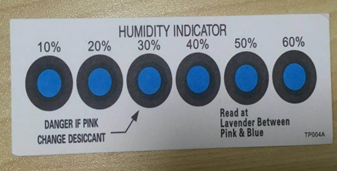
-
-
The module needs to be baked in the following cases:
- The vacuum packaging bag is damaged before unpacking.
- After unpacking, no HIC is found in the packaging bag.
- After unpacking, the HIC indicates a humidity level of 10% or higher. In this case, the circle turns pink on the HIC.
- The total exposure time has lasted for over 168 hours since unpacking.
- More than 12 months have passed since the first sealing of the bag.
-
The baking parameter settings are described below:
- Baking temperature: 40°C for reel packaging with relative humidity ≤ 5%. And 125°C for tray packaging with relative humidity ≤ 5% (use a heat-resistant tray, rather than plastic containers).
- Baking time: 168 hours for reel packaging and 12 hours for tray packaging.
- Temperature for triggering an alert: 50°C for reel packaging and 135°C for tray packaging.
- Production can begin after a module has cooled down to below 36°C under natural conditions.
- If a module remains unused for over 168 hours after being baked, it needs to be baked again.
- If a batch of modules is not baked after exposure for more than 168 hours, do not use wave soldering to solder them. Because these modules are level-3 moisture-sensitive devices, they are very likely to get damp when exposed beyond the allowable time. In this case, if they are soldered at high temperatures, device failure or poor soldering performance might occur.
-
In the whole production process, take electrostatic discharge (ESD) protective measures.
-
To guarantee the pass rate, we recommend that you use the SPI and AOI to monitor the quality of solder paste printing and mounting.
Recommended oven temperature curve
Set the temperature according to the following temperature curve of reflow soldering. The peak temperature is 245°C.
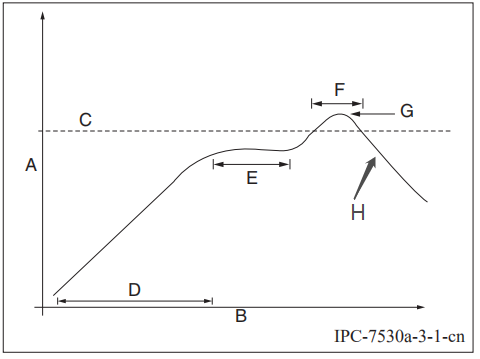
-
A: temperature axis
-
B: time axis
-
C: alloy liquidus temperature from 217°C to 220°C
-
D: ramp-up slope from 1°C/s to 3°C/s
-
E: keep a constant temperature from 150°C to 200°C for a time period from 60s to 120s
-
F: temperature above liquidus temperature for 50s to 70s
-
G: peak temperature from 235°C to 245°C
-
H: ramp-down slope from 1°C/s to 4°C/s
The curve above is based on solder paste SAC305. For more information about other solder pastes, see the recommended oven temperature curve in the specified solder paste specifications.
Storage conditions

MOQ and packaging information
| Model | MOQ (pcs) | Shipping packaging | Modules per reel | Reels per carton |
|---|---|---|---|---|
| TYAUX-J2 | 3,600 | Tape and reel | 900 | 4 |
Appendix: Statement
FCC Caution: Any changes or modifications not expressly approved by the party responsible for compliance could void the user’s authority to operate this device.
This device complies with Part 15 of the FCC Rules. Operation is subject to the following two conditions: (1) This device may not cause harmful interference, and (2) this device must accept any interference received, including interference that may cause undesired operation.
List of applicable FCC rules
This module has been granted modular approval as below listed FCC rule parts.
FCC Rule parts 15C (15.247)
List of applicable ISED rules
This module has been certificated modular approval as below listed ISED Radio Standards Specifications.
RSS 247 Issue 3
This device generates, uses, and can radiate radio frequency energy and, if not installed and used following the instructions, may cause harmful interference to radio communications. However, there is no guarantee that interference will not occur in a particular installation. If this device does cause harmful interference to radio or television reception, which can be determined by turning the device off and on, the user is encouraged to try to correct the interference by one or more of the following measures:
• Reorient or relocate the receiving antenna.
• Increase the separation between the device and receiver.
• Connect the device to an outlet on a circuit different from that to which the
receiver is connected.
• Consult the dealer or an experienced radio/TV technician for help.
Radiation Exposure Statement
This device complies with FCC radiation exposure limits set forth for an uncontrolled rolled environment. This device should be installed and operated with a minimum distance of 20cm between the radiator and your body.
Important Note
This radio module must not be installed to co-locate and operate simultaneously with other radios in the host system except by following FCC multi-transmitter product procedures. Additional testing and device authorization may be required to operate simultaneously with other radios.
The availability of some specific channels and/or operational frequency bands are country-dependent and are firmware programmed at the factory to match the intended destination. The firmware setting is not accessible to the end-user.
The host product manufacturer is responsible for compliance with any other FCC rules that apply to the host not covered by the modular transmitter grant of certification. The final host product still requires Part 15 Subpart B compliance testing with the modular transmitter installed.
The end-user manual shall include all required regulatory information/warnings as shown in this manual, including “This product must be installed and operated with a minimum distance of 20 cm between the radiator and user body”.
This device has got an FCC ID: 2ANDL-TYAUX-J2. The end product must be labeled in a visible area with the following: “Contains Transmitter Module FCC ID: 2ANDL-TYAUX-J2”.
This device is intended only for OEM integrators under the following conditions:
The antenna must be installed such that 20cm is maintained between the antenna and users, and the transmitter module may not be co-located with any other transmitter or antenna.
As long as the 2 conditions above are met, further transmitter tests will not be required. However, the OEM integrator is still responsible for testing their end-product for any additional compliance requirements required with this module installed.
Declaration of Conformity European Notice

Hereby, Hangzhou Tuya Information Technology Co., Ltd declares that this module product is in compliance with essential requirements and other relevant provisions of Directive 2014/53/EU,2011/65/EU. A copy of the Declaration of Conformity can be found at https://www.tuya.com.

This product must not be disposed of as normal household waste, in accordance with the EU directive for waste electrical and electronic equipment (WEEE-2012/19/EU). Instead, it should be disposed of by returning it to the point of sale, or to a municipal recycling collection point.
The device could be used with a separation distance of 20cm from the human body.
Industry Canada Statement
This device complies with Industry Canada’s licence-exempt RSSs. Operation is subject to the following two conditions:
(1) This device may not cause interference.
(2) This device must accept any interference, including interference that may cause undesired operation of the device.
Le présent appareil est conforme aux CNR d’Industrie Canada applicables aux appareils radio exempts de licence. L’exploitation est autorisée aux deux conditions suivantes:
(1) l’appareil ne doit pas produire de brouillage.
(2) l’utilisateur de l’appareil doit accepter tout brouillage radioélectrique sub i, même si le brouillage est susceptible d’en compromettre le fonctionnement.
Radiation Exposure Statement
This equipment complies with IC radiation exposure limits set forth for an uncontrolled environment. This equipment should be installed and operated with minimum distance 20 cm between the radiator & your body.
Déclaration d’exposition aux radiations:
Cet équipement est conforme aux limites d’exposition aux rayonnements ISED établies pour un environnement non contrôlé. Cet équipement doit être installé et utilisé avec un minimum de 20 cm de distance entre la source de rayonnement et votre corps.
L’appareil peut interrompre automatiquement la transmission en cas d’absence d’informations à transmettre ou de panne opé rationnelle. Notez que ceci n’est pas destiné à interdire la transmission d’informations de contrôle ou de signalisation ou l’utilisation de codes répétitifs lorsque cela est requis par la technologie.
This device is intended only for OEM integrators under the following conditions:
(1) The antenna must be installed such that 20 cm is maintained between the antenna and users.
(2) The transmitter module may not be co-located with any other transmitter or antenna. As long as 2 conditions above are met, further transmitter test will not be required.
However, the OEM integrator is still responsible for testing their end-product for any additional compliance requirements required with this module installed.
Cet appareil est conçu uniquement pour les intégrateurs OEM dans les conditions
suivantes: (Pour utilisation de dispositif module)
(1) L’antenne doit être installée de telle sorte qu’une distance de 20 cm est respectée entre l’antenne et les utilisateurs.
(2) Le module émetteur peut ne pas être coïmplanté avec un autre é metteur ou antenne.
Tant que les 2 conditions ci-dessus sont remplies, des essais supplé mentaires sur l’émetteur neseront pas nécessaires. Toutefois, l’intégrateur OEM est toujours responsable des essais sur son produit final pour toutes exigences de conformité supplémentaires requis pour ce module installé.
IMPORTANT NOTE:
In the event that these conditions can not be met (for example certain laptop configurations or colocation with another transmitter), then the Canada authorization is no longer considered valid and the IC ID can not be used on the final product. In these circumstances, the OEM integrator will be responsible for re-evaluating the end product (including the transmitter) and obtaining a separate Canada authorization.
NOTE IMPORTANTE:
Dans le cas où ces conditions ne peuvent être satisfaites (par exemple pour certaines configurations d’ordinateur portable ou de certaines co-localisation avec un autre émetteur), l’autorisation du Canada n’est plus considéré comme valide et l’ID IC ne peut pas être utilisé sur le produit final. Dans ces circonstances, l’intégrateur OEM sera chargé de réévaluer le produit final (y compris l’émetteur) et l’obtention d’une autorisation distincte au Canada.
End Product Labeling
This transmitter module is authorized only for use in device where the antenna may be installed such that 20 cm may be maintained between the antenna and users. The final end product must be labeled in a visible area with the following: “Contains IC:23243-TYAUXJ2” .
Plaque signalétique du produit final
Ce module émetteur est autorisé uniquement pour une utilisation dans un dispositif où l’antenne peut être installée de telle sorte qu’une distance de 20cm peut être maintenue entre l’antenne et les utilisateurs. Le produit final doit être étiqueté dans un endroit visible avec l’inscription suivante: “Contient des IC:23243-TYAUXJ2”.
Manual Information To the End User
The OEM integrator has to be aware not to provide information to the end user regarding how to install or remove this RF module in the user’s manual of the end product which integrates this module.
The end user manual shall include all required regulatory information/warning as show in this manual.
Manuel d’information à l’utilisateur final
L’intégrateur OEM doit être conscient de ne pas fournir des informations à l’utilisateur final quant à la façon d’installer ou de supprimer ce module RF dans le manuel de l’utilisateur du produit final qui intègre ce module.
Le manuel de l’utilisateur final doit inclure toutes les informations réglementaires requises et avertissements comme indiqué dans ce manuel.
Is this page helpful?
YesFeedbackIs this page helpful?
YesFeedback





